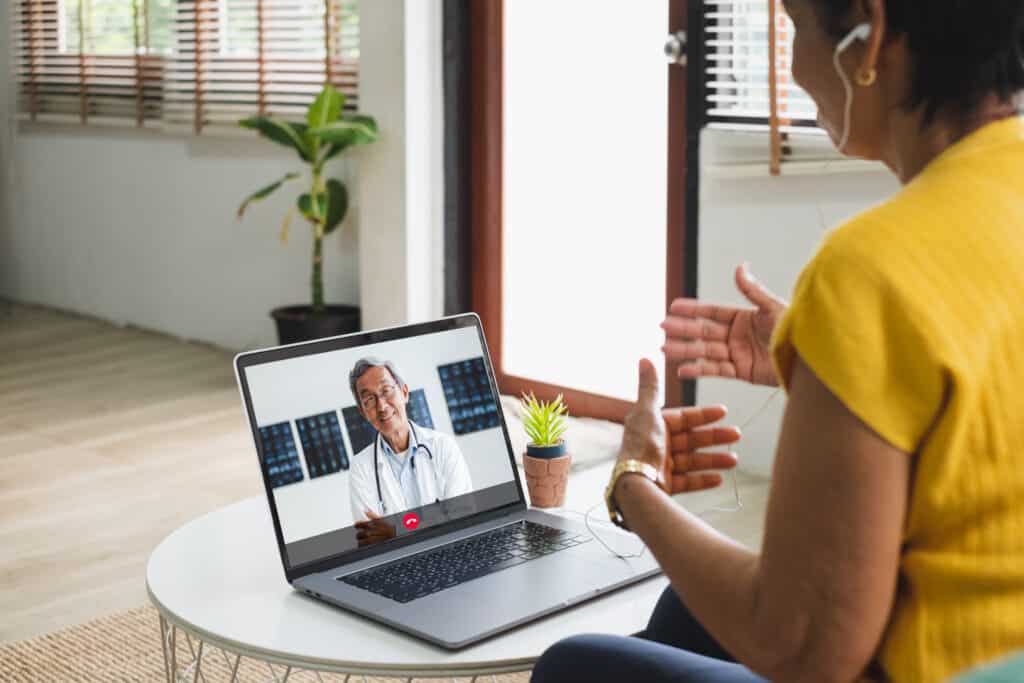Approximately 20% of Americans reside in rural areas of the country. Unfortunately, these communities have long faced unique healthcare challenges and inequities, including shortages of healthcare professionals and limited infrastructure. But it doesn’t end there.
According to the Centers for Disease Control and Prevention (CDC), rural residents also:
- Tend to be older and sicker than people living in urban areas
- Have higher rates of cigarette smoking, high blood pressure, and obesity
- Experience higher rates of poverty, less access to healthcare, and lower rates of health insurance coverage.
In the past decade, telehealth has emerged as a powerful tool to address these challenges in rural areas, improving healthcare access and transforming patient outcomes for patients living in rural areas of the country.
This article discusses rural health disparities in the United States, the role telehealth plays in improving health access, telehealth use cases and success stories, and the future of rural healthcare and telehealth.
Key Takeaways:
- Gain a deeper understanding of rural health disparities.
- Learn the benefits of telehealth in rural areas and explore successful programs/use cases.
- Uncover key features of telehealth solutions.
- Discover the future of telemedicine in rural healthcare.
Understanding Rural Health Disparities
What are Rural Health Disparities?
Rural health disparities refer to the differences in health outcomes and access to healthcare in rural communities compared to urban areas. These disparities result from a combination of factors, including limited access to healthcare facilities, a shortage of healthcare providers, socioeconomic challenges, and transportation difficulties.
Consequently, rural populations often experience higher rates of chronic diseases, lower preventive care uptake, and increased mortality rates.

Barriers to Healthcare Access in Rural Areas
According to the Rural Health Information Hub (RHI Hub), several obstacles hinder healthcare access in rural areas, including:
- Long travel distances to medical facilities
- Lack of specialists
- Social determinants of health (SDOH), which are the conditions, such as income, education, demographics, and infrastructure in the environments where people live, learn, work, and age, that affect a range of health and quality-of-life outcomes and risks
- Health insurance status; there are higher rates of uninsured individuals in rural areas as compared to urban ones
- Poor health literacy
- Inadequate healthcare infrastructure; the cost of implementing telemedicine technology in a rural hospital can range from $17,000 to $50,000
- Technological limitations such as broadband internet
These barriers can lead to delayed diagnoses, untreated conditions, and poorer overall health outcomes among rural populations.
RELATED ARTICLE: Growth Strategies for Patient Access & Equity
The Role of Telehealth in Improving Rural Health Access
How Telehealth Expands Healthcare Access in Rural Areas
Telehealth in rural areas transforms healthcare access by bridging geographic divides. Virtual care for rural patients allows for consultations, diagnostics, and follow-up care to be delivered remotely, reducing the need for travel and addressing provider shortages.
This not only ensures that care is more consistent and timelier but also enhances healthcare access in rural areas, especially for those with mobility issues or transportation challenges.
Benefits of Telehealth in Rural Areas
Telehealth offers more than just convenience. It improves health outcomes in rural healthcare through increased access to specialists and mental health services.
Additionally, virtual visits reduce healthcare costs, alleviate the burden on local facilities, and enable proactive management of chronic diseases. For example, telehealth can reduce the number of in-person visits and follow-up appointments, which can lead to lower operational expenses. Cost benefits also extend to patients, with average savings ranging from $19 to $121 per telehealth visit. The expanded reach of healthcare professionals ensures rural residents receive comprehensive care tailored to their needs.
RELATED ARTICLE: Telehealth Infographic: 5 Statistics Every Physician Should Know

Telehealth Use Cases in Rural Healthcare
Chronic Disease Management in Rural Areas
Remote healthcare delivery is instrumental in managing chronic illnesses such as diabetes, hypertension, heart conditions, and COPD. Telehealth enables regular monitoring, medication adjustments, and patient education—essential components for effective disease management.
Use Case:
According to the National Rural Health Association (NRHA), rural hospitals use telehealth technologies for telecardiology, telestroke, teleneurology, and telebehavioral health, ensuring that patients with critical and chronic heart conditions receive care.
For example, a stroke patient can receive care within the “golden hour,” a crucial window for intervention that would otherwise be lost during transfers to distant facilities.
Mental Health Telehealth in Rural Settings
Access to mental health services is especially limited to underserved communities. Telehealth enables remote delivery of mental health services such as therapy, psychiatric consultations, and crisis intervention remotely, helping to reduce stigma and meet the mental health needs of rural populations more effectively.
Use Case:
AMP Mental Health struggled with its outdated electronic health system (EHR) system, dealing with manual appointment confirmations and disorganized paper-based intake forms. The lack of cloud-based integrations also resulted in inefficiencies in billing, customer service, and operational workflows.
These issues hindered their ability to earn patient trust, effectively provide telehealth services, and expand patient access.
The organization turned to Updox to provide a secure, all-in-one platform that digitized workflows and automated patient communications. The solution enhanced telehealth capabilities and allowed for seamless integration with their EHR. Other improvements included:
- Enhanced appointment tracking and significantly reduced no-shows
- Expanded telehealth offerings increased patient access and improved care outcomes
- Enhanced billing and operational efficiencies led to improved patient engagement and more effective resource allocation
According to Lily Oquendo-Ortiz, AMP’s practice manager, “Updox has led to a more organized practice, improved patient flow, and a better allocation of resources, contributing to enhanced overall productivity.”
Telehealth for Elderly Care in Rural Settings
Older adults in rural areas often face difficulties accessing routine healthcare, leading to untreated conditions and declining quality of life. Telehealth facilitates elder care by providing regular check-ups, mental health support, medication management, and emergency services, keeping seniors healthier and more independent.
For example, Kathy Hsu Wibberly, Director of the Mid-Atlantic Telehealth Resource Center (MATRC), states in an RHI Hub article that “for long-term care residents with memory disorders, traveling to another facility for care can be a stressful experience. Telehealth allows them to stay in an environment where they feel comfortable, safe, and where they have familiarity.”
Use Case:
Psychiatric Mental Health Nurse Practitioner, George, founded OhanaPsych with his wife, Heather, to ensure everyone in Hawaii has access to quality psychiatric care. The telepsychiatry practice has an entirely remote staff of eight providers and eight support professionals.
OhanaPsych recognized the need for a HIPAA-compliant, integrated EHR platform to communicate effectively and efficiently. They also wanted an option that staff could access remotely.
The organization decided to utilize the Updox telehealth platform. The solution enabled OhanaPsych to succeed as a completely remote practice as it facilitates HIPAA-compliant video and audio calls with a virtual waiting room that mimics an in-person visit. It also easily integrated with their existing EHR. Other benefits included:
- Secure and flexible SMS that allows their patients to communicate with providers at their convenience
- eForms that simplified their intake process and reduced unnecessary paperwork
- An easy-to-use platform that enabled the staff to cross-train, boosting practice efficiency
- Text, email, or phone call reminder capabilities that reduced no-shows
George states, “If it weren’t for Updox, we couldn’t run a lean operation without physical locations, and we wouldn’t be in business.”

Telemedicine in Rural Communities: Technology & Infrastructure
Building Telehealth Infrastructure in Rural Areas
Establishing reliable broadband internet, investing in appropriate hardware, and training healthcare providers are critical steps in building telehealth infrastructure.
Partnerships between governments, healthcare systems, and tech companies can accelerate these efforts, ensuring technology is readily available for remote healthcare delivery.
Key Features of Telehealth Solutions for Rural Healthcare
Every interaction with patients is an opportunity to build—or lose—trust. Offering secure and effective telehealth solutions for your rural healthcare patients can create deeper loyalty and trust.
These tools also facilitate comprehensive care, enabling you to make informed clinical decisions remotely. Key features should include:
- User-friendly interfaces
- Secure platforms with HIPAA-compliant video conferencing for patient privacy
- Seamless integration with EHR systems
As described earlier, Updox, a communication platform that integrates with EHRs, offers a HIPAA-compliant telehealth software solution. This platform enables you to connect with patients face to face, regardless of their location, through video and audio calls.
Features include:
- A virtual waiting room with enhanced flexibility that enables triage workflows that mimic an in-person visit
- Interpreter services to increase accessibility and optimize the patient experience
- Ability to host telehealth conferences with up to 20 attendees as needed
Improving Rural Health Outcomes Through Telehealth
Measurable Benefits and Success Stories
Numerous success stories highlight how telehealth has improved patient outcomes in rural healthcare. For instance, programs that use telemedicine in rural communities have reported reductions in deaths and improved management of chronic and emergency conditions. We share two success stories below.
Success Story #1:
The Sanford Health system expanded its emergency services by utilizing telehealth. This partnership enables rural emergency staff to communicate with specialists quickly. The specialists provide guidance on treating strokes, burns, and other medical traumas.
For example, when a patient arrives at a rural emergency room, the staff promptly responds. They use a virtual care hub to start a live video connection. The virtual hub connects rural emergency staff with specialists. This helps increase access and works to prevent avoidable deaths.
Success Story #2:
East Carolina University created a program that provides healthcare both in person and virtually and includes a nurse visit to the patient’s home. Using telehealth, the nurse and patient meet virtually with a provider at a health center.
Patients can also use this technology to consult with various types of healthcare providers and connect virtually with a pharmacist. Because the nurse is sitting next to the patient during the telehealth visit, they can assess if additional care is needed.
Through the combination of telehealth and in-person care, health issues are more readily discoverable and actionable because the care team comes together.
Next Steps for Expanding Telehealth in Rural Communities
To further expand telehealth, policymakers and healthcare organizations should focus on increasing broadband access, funding telehealth programs, and developing sustainable reimbursement models.
For example, the CDC is supporting telehealth projects nationwide to provide rural residents with better access to chronic disease prevention and management programs, as well as specialist care.
One project, called the Screening and Intervention for Glaucoma and Eye Health through Telemedicine (SIGHT) studies, is working to improve glaucoma screening and management among populations at high risk for glaucoma.
Final Thoughts: The Future of Rural Healthcare and Telehealth
The future of rural healthcare is increasingly intertwined with telehealth innovations. As technology continues to evolve, virtual care for rural patients will become more integrated, reliable, and comprehensive.
Expanding telehealth in rural areas holds the promise of closing healthcare disparities, improving patient outcomes in rural healthcare, and building healthier, more resilient, and underserved communities.
Ready to invest in patient-centered solutions? Contact Updox to discover how our telehealth platform can ensure that your patients receive the high-quality care they deserve, regardless of their location.
Frequently Asked Questions (FAQs)
What is telehealth in rural areas?
Telehealth in rural areas refers to the delivery of healthcare services remotely via digital communication tools, such as video calls, remote monitoring, and mobile health apps. It enables rural residents to access medical care without the need to travel long distances.
What are the main barriers to healthcare access in rural areas?
Major barriers to healthcare in rural areas include long travel distances to healthcare facilities, shortages of healthcare providers, limited broadband internet access, transportation challenges, and financial constraints. These obstacles often delay or prevent residents from receiving necessary care.
How does telehealth help manage chronic diseases in rural areas?
Telehealth enables remote monitoring, medication adjustments, and patient education for chronic conditions like diabetes and hypertension. This ongoing virtual care improves disease control, prevents complications, and reduces hospitalizations.
What infrastructure is needed to support telehealth in rural communities?
Reliable high-speed internet, suitable hardware, secure telemedicine platforms, and training for both healthcare providers and patients are essential. Partnerships with technology providers and government programs can help develop this infrastructure.
What steps are needed to expand telehealth in rural communities?
Continued investment in broadband infrastructure, sustainable reimbursement policies, increased awareness of virtual care options, and ongoing education for both providers and patients are key to expanding telehealth services.





